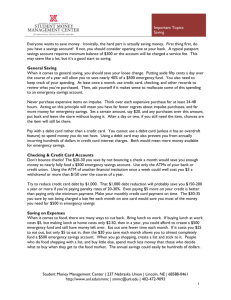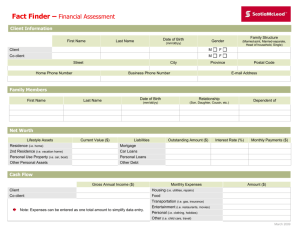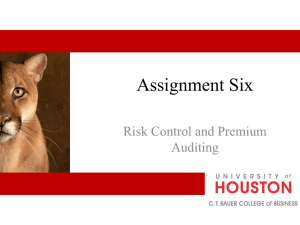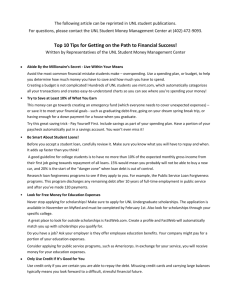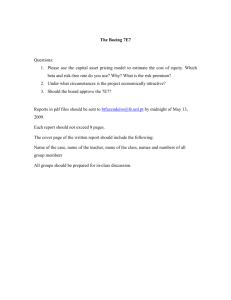Funder*s Name - University of Nebraska–Lincoln
advertisement
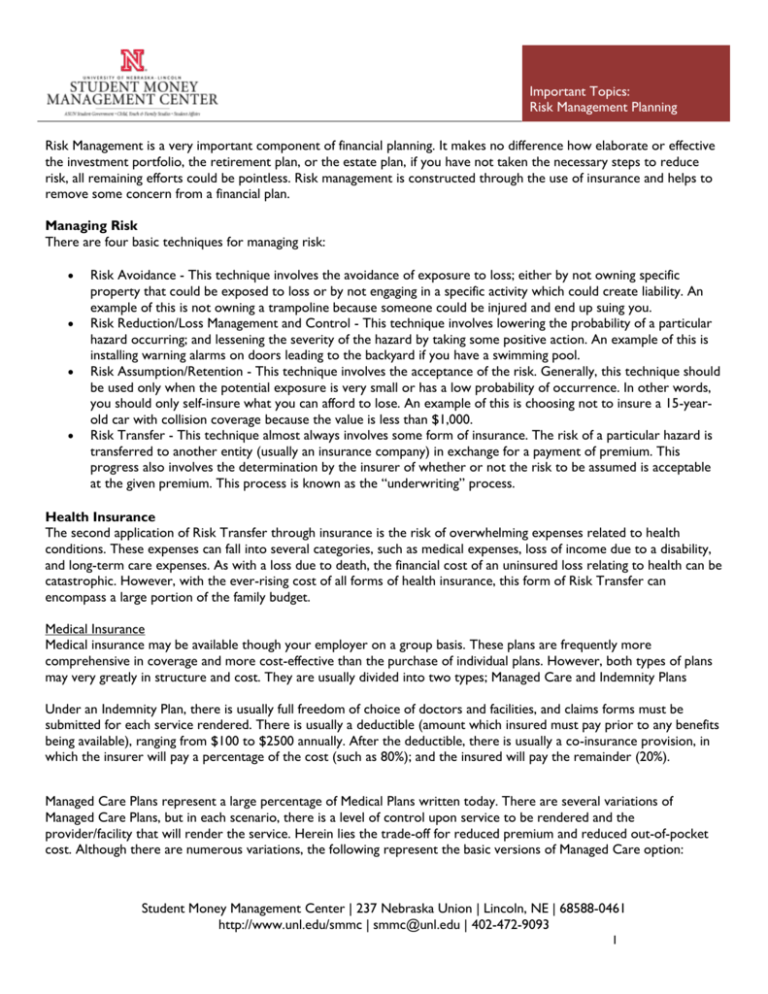
Important Topics: Risk Management Planning Risk Management is a very important component of financial planning. It makes no difference how elaborate or effective the investment portfolio, the retirement plan, or the estate plan, if you have not taken the necessary steps to reduce risk, all remaining efforts could be pointless. Risk management is constructed through the use of insurance and helps to remove some concern from a financial plan. Managing Risk There are four basic techniques for managing risk: Risk Avoidance - This technique involves the avoidance of exposure to loss; either by not owning specific property that could be exposed to loss or by not engaging in a specific activity which could create liability. An example of this is not owning a trampoline because someone could be injured and end up suing you. Risk Reduction/Loss Management and Control - This technique involves lowering the probability of a particular hazard occurring; and lessening the severity of the hazard by taking some positive action. An example of this is installing warning alarms on doors leading to the backyard if you have a swimming pool. Risk Assumption/Retention - This technique involves the acceptance of the risk. Generally, this technique should be used only when the potential exposure is very small or has a low probability of occurrence. In other words, you should only self-insure what you can afford to lose. An example of this is choosing not to insure a 15-yearold car with collision coverage because the value is less than $1,000. Risk Transfer - This technique almost always involves some form of insurance. The risk of a particular hazard is transferred to another entity (usually an insurance company) in exchange for a payment of premium. This progress also involves the determination by the insurer of whether or not the risk to be assumed is acceptable at the given premium. This process is known as the “underwriting” process. Health Insurance The second application of Risk Transfer through insurance is the risk of overwhelming expenses related to health conditions. These expenses can fall into several categories, such as medical expenses, loss of income due to a disability, and long-term care expenses. As with a loss due to death, the financial cost of an uninsured loss relating to health can be catastrophic. However, with the ever-rising cost of all forms of health insurance, this form of Risk Transfer can encompass a large portion of the family budget. Medical Insurance Medical insurance may be available though your employer on a group basis. These plans are frequently more comprehensive in coverage and more cost-effective than the purchase of individual plans. However, both types of plans may very greatly in structure and cost. They are usually divided into two types; Managed Care and Indemnity Plans Under an Indemnity Plan, there is usually full freedom of choice of doctors and facilities, and claims forms must be submitted for each service rendered. There is usually a deductible (amount which insured must pay prior to any benefits being available), ranging from $100 to $2500 annually. After the deductible, there is usually a co-insurance provision, in which the insurer will pay a percentage of the cost (such as 80%); and the insured will pay the remainder (20%). Managed Care Plans represent a large percentage of Medical Plans written today. There are several variations of Managed Care Plans, but in each scenario, there is a level of control upon service to be rendered and the provider/facility that will render the service. Herein lies the trade-off for reduced premium and reduced out-of-pocket cost. Although there are numerous variations, the following represent the basic versions of Managed Care option: Student Money Management Center | 237 Nebraska Union | Lincoln, NE | 68588-0461 http://www.unl.edu/smmc | smmc@unl.edu | 402-472-9093 1 Important Topics: Risk Management Planning HMOs (Health Maintenance Organizations) These organizations may be sponsored by an insurance company or by the actual care providers themselves (doctors, hospitals, etc.) The member pays a monthly fee, and there is also generally a fee ("co-pay") required each time that a service is rendered. These co-pays range from $10 to $20 for routine physician office visits to $100 or more for hospital admissions. PPOs (Preferred Provider Organizations) Like HMOs, these organizations may be sponsored by an insurance company or by care-providers. But there is somewhat more freedom of choice. Most plans feature benefits both inside and outside the network. Of course, use of the out of network providers results in higher out of pocket costs, through higher co-pays, deductibles or co-insurance. Long Term Care Insurance Long Term Care has become an important focus for our nation, due to the aging of America. Living to advanced ages brings its own problems to include the need for assisted living and changes in life-style. Long term care is assistance-inliving that must be provided for an individual due to illness or injury. This may include full-skilled care for the bed-ridden patient, or may only involve some assistance with ADLs (Activities of Daily Living) such as bathing, dressing, toileting, administering medication, etc. These services may be provided in a long-term nursing facility; a congregate or assistedliving facility, or even within the patient’s or a family member’s home. Disability Income Insurance The odds of becoming disabled are greater at any age than are the odds of dying at that same age; yet many working adults have not made any provision to manage this risk. In many ways, disability is a more expensive risk to manage, and there are usually extra medical and care-giving costs which actually increase the cost of living. Just as with medical insurance, group disability plans may be available to you through your employer, and if so, they may be more costeffective than purchasing your own individual policy. Insurance industry studies indicate the following comparative odds of becoming disabled vs. dying at a given age: At Age 27 = 2.7 times greater At Age 42 = 3.5 times greater At Age 52 = 2.2 times greater Property and Liability Insurance The third and final application of Risk Transfer through insurance that we will address relates to the catastrophic losses of real and personal property caused by such hazards as fire, theft, vandalism, storms and the liability of legal actions. Homeowner’s Insurance Your home is usually your biggest and most expensive asset, and represents a significant risk of loss, so it is very important that it be adequately insured. There are four types of Homeowners Policies. HO-1, HO-2, HO-3, and HO-8 are available to resident owners only. HO-4 is for renters, and HO-6 is for condominium owners. HO-3 is the most complete coverage, and the most frequently-sold policy. All of these policies contain two sections: Section I – Property Loss Exposure which covers a loss of any of the following due to a peril stated in the policy: o Dwelling o Other Structures o Personal Property o Loss of Use Student Money Management Center | 237 Nebraska Union | Lincoln, NE | 68588-0461 http://www.unl.edu/smmc | smmc@unl.edu | 402-472-9093 2 Important Topics: Risk Management Planning Section II – Liability Loss Exposure (E) which covers personal liability (lawsuit protection) and Medical Payments to Others (F) The Personal Property Floater (PPF) is a rider which provides additional protection for items not adequately covered in a standard homeowners policy, such as furs, jewelry, photography equipment, silverware, art, antiques, musical instruments, and collections Generally, coverages B through D are expressed as a percentage of the home (A) o o o Other Structures (B) 10% Personal Property ( C ) 50% Loss of Use (D) 10 - 20% The minimum policy limit of liability is generally $100,000 and Medical Payments is generally $1,000 per person. These limits may be increased for a slightly higher premium. Most financial advisers recommend a minimum of $300,000 on liability limits for both homeowners and auto policies. Automobile Insurance State law determines whether auto coverage will be handled on a standard policy basis or the "no-fault" basis. Under a Standard Policy, there are four sections: Section A – Liability Coverage o This pays for damages for bodily injury and property damage for which you may become legally obligated due to an auto accident. Section B – Medical Payments Coverage o This pays reasonable and necessary medical expenses incurred within three years of an auto accident and only up to policy limits. Section C – Uninsured Motorists Coverage o This coverage is provided to accident victims negligently injured by an uninsured or hit-and-run motorist. Section D – Coverage For Physical Damage To Vehicle o This provision pays for collision damage, regardless of fault. Damages are paid in an amount up to actual cash value (replacement cost less depreciation) of the loss in excess of stated deductible (usually $250 to $500). There are many difference factors that will affect your auto premium rates. One factor affecting your premium is your geographic location. Some geographic locations have worse claims experience than others; therefore, premiums are higher in these areas. Another factor is the use of the insured car. Rates are higher for autos driven to work. Total miles driven may also be considered a risk-increasing factor. Other factors include type of car, personal characteristics of the drivers, and driving record. Life Insurance The first application of Risk Transfer through insurance that we will address is the risk of death. Death always involves a financial loss, especially if the deceased was the only income earner. Some of the financial needs that may be created by a death are as follows: Final personal expenses – final medical expenses, funeral, burial, etc. Student Money Management Center | 237 Nebraska Union | Lincoln, NE | 68588-0461 http://www.unl.edu/smmc | smmc@unl.edu | 402-472-9093 3 Important Topics: Risk Management Planning Estate / death expenses – estate settlement costs to include federal and state estate taxes, probate, legal, accounting, appraisal fees, etc. Family income – support for surviving spouse and dependent children Additional expenses – necessary additional household services, childcare, etc. Liquidation of debts – payoff of mortgage, auto loan, credit cards educational loans, etc. Special financial needs – care of aging parents, special needs child, or other family member Liquidity – emergency fund; necessary immediate cash flow Funding of established financial goals – completing college funding; purchase of second home, pay off the mortgage, etc. There are several types of life insurance; each with numerous variations. The type of coverage that is best for you depends on a number of factors. Term Insurance Term insurance is purchased for a certain period of time. During that term, premiums are paid, and a death benefit will be received if death occurs. There is no cash value build-up. Premiums on term plans are considerably less expensive than with other plans. At the end of the term, the insured will be faced with one of several choices, depending on the type of term policy purchased. If the need for insurance still exists, the insured will have to apply to purchase a new term policy; generally requiring evidence of insurability (good health); or may be allowed to continue with the existing plan, but at a higher premium. Whole Life This is the oldest form of permanent/cash value life insurance. It features a guaranteed premium, a guaranteed cash value, and a guaranteed death benefit. The cash value earns a minimum guaranteed rate of return and may also receive dividends or additional interest. Universal Life This policy contains two components; insurance costs and the cash value component. Interest is paid on the cash value, with returns being similar to current money market returns. Death benefit may be structured to be level (Option A) or may increase as cash values increase (Option B). All aspects of coverage (pure insurance cost; policy administrative charges; premiums; interest credited to cash accumulation, etc.) are detailed separately and disclosed on an annual policy statement. Variable/Variable-Universal Life This policy allows policyholders to make decisions concerning where the cash value portion of premium is invested. Policies generally offer a variety of investment alternatives. Note: This paper was written by representatives at the University of North Texas Student Money Management Center and is being used by permission of the University of North Texas Student Money Management Center. Source: http://learningforlife.fsu.edu/course/fp101/fp-Insurance-text.htm Student Money Management Center | 237 Nebraska Union | Lincoln, NE | 68588-0461 http://www.unl.edu/smmc | smmc@unl.edu | 402-472-9093 4
